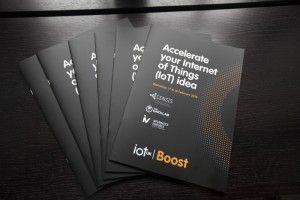
SMEs pitch up for IoT challenge
- This project was covered by The Scotsman and several other publications in February 2016
Follwing a competitive bidding process, CENSIS was selected as one of four regional partners for the IoTUK Boost initiative designed to amplify the UK’s IoT capability and opportunities. IoTUK Boost supports IoT innovation and adoption across business and the public sector and will see a collaboration between the selected local partners and the Catapults.
Maurizio Pilu, Executive Director for Collaborative R&D, Digital Catapult said: “The Internet of Things has the potential to transform businesses and public sector organisations across the UK, as well as drive economic growth and social change. No individual, company or government can do this alone; it can only be achieved through collaboration and bringing together innovators with challenge owners, and it has to especially be achieved at the local level, leveraging the wealth and diversity of talent across the UK. The IoTUK Boost programme will do just this, a coordinated acceleration programme in the IoT across regions to grow new business opportunities in IoT in, and for, the UK”.
The companies were supported with a programme of activity and access to expertise co-ordinated by CENSIS and including The Data Lab, Informatics Ventures and IoTUK, that focused on cultivating valuable links with other organisations and developing a robust and fundable idea for a product or service.
The two-day IoTUK Boost workshop (17-18 February 2016) in Glasgow saw 18 of Scotland’s most innovative SMEs go head-to-head in front of a panel of judges to win one month of incubation support and mentoring aimed at helping the companies bring their commercial ideas to market.
Five companies were selected for a month’s worth of support. Winners also attended the Cambridge IoT Forum in March 2016. you can also catch up on photos from the day on Flickr.
IoTUK Boost Glasgow WINNERS:
Sansible Wearables: Jack Ng and Charlie Patterson
Awarded the ‘One to Watch’ by IoTUK, Sansible Wearables develops wearable technology products that provide the ability to ‘feel’ and connect this personal experience of force to smart phones and tablets. Athletes, sport coaches and physios can use the data to tailor training or rehabilitation schedules for athletes. The first markets are rugby and American football, where force is the most dominant factor of the game play and users can benefit from the high details of the biomechanics data the product provides.
FUELlink Systems: John Ashley and Graeme Turner
An online fuel management company, FuelLink Systems manages supplies, and services for vehicle refuelling throughout the UK and Ireland. Our project is a vehicle based telemetry system with roadside data collection points that will obtain vehicle data and provide operators and users with relevant information. This is to ensure smooth and efficient running within optimal parameters for users and operators. FuelLink Systems launched its product, VINIE, at the Euro Bus Expo 2016 offering automatic vehicle identification, odometer transfer and fuel tank level via Bluetooth. Read the FUELlink article in The Herald
OBrand Communications: Gatis Gaumigs and Rafal Ciesielczuk
OBrand Communications is a high tech start-up founded on innovative wireless connectivity within the advertising industry. The company aims to distinguish itself as a brand for lifestyle activities and as providers for an information rich mobile environment. Our target business audience can be described as social venues such as coffee shops, bars and restaurants. Since our services are being founded on location aware technology, we would provide benefits to both the clients and end users. Read the OBrand article in The Herald
Rapport Network: Gary Cornelius and Alasdair Thin
Rapport Network can make a massive improvement in the way that people with early stage dementia can continue to live confidently and securely in their own home by providing assistive living technology. This technology also connects people with their own family, friends and carers in a secure and reliable way. We help people capture, self-assess and share their needs, we help match people with assistive technology and use it to reduce upsetting and/or dangerous events.
The WindOP: Andy Maginnis
thewindop.com was born from the experiences of three kitesurfers in Scotland who wanted to know in real time the actual conditions from the end of their local beach. The data available at the time was either very late in being displayed, very poor resolution or inaccurate due to the weather stations being located some distance away from the beach so they set out to build a autonomous solar powered system.